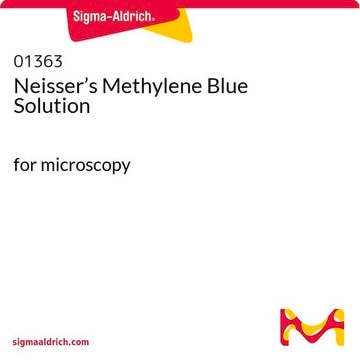77515
Methylene Blue solution
for microscopy
Synonyme(s) :
Loeffler’s Methylene Blue
About This Item
Produits recommandés
Qualité
for microscopy
Forme
solution
Durée de conservation
limited shelf life, expiry date on the label
Technique(s)
microbe id | staining: suitable
Spectre d'activité de l'antibiotique
Gram-negative bacteria
Gram-positive bacteria
Adéquation
Corynebacterium spp.
bacteria
mycobacteria
spore forming microorganisms
Chaîne SMILES
[Cl-].CN(C)c1ccc2N=C3C=C\C(C=C3Sc2c1)=[N+](/C)C
InChI
1S/C16H18N3S.ClH/c1-18(2)11-5-7-13-15(9-11)20-16-10-12(19(3)4)6-8-14(16)17-13;/h5-10H,1-4H3;1H/q+1;/p-1
Clé InChI
CXKWCBBOMKCUKX-UHFFFAOYSA-M
Vous recherchez des produits similaires ? Visite Guide de comparaison des produits
Catégories apparentées
Application
Composants
methylene blue 0.3 g
ethanol 30 ml
water 100 ml
Autres remarques
Remplacé(e)(s) par
Mention d'avertissement
Warning
Mentions de danger
Conseils de prudence
Classification des risques
Flam. Liq. 3
Code de la classe de stockage
3 - Flammable liquids
Classe de danger pour l'eau (WGK)
WGK 2
Point d'éclair (°F)
113.0 °F
Point d'éclair (°C)
45 °C
Équipement de protection individuelle
Eyeshields, Faceshields, Gloves, type ABEK (EN14387) respirator filter
Choose from one of the most recent versions:
Déjà en possession de ce produit ?
Retrouvez la documentation relative aux produits que vous avez récemment achetés dans la Bibliothèque de documents.
Les clients ont également consulté
Notre équipe de scientifiques dispose d'une expérience dans tous les secteurs de la recherche, notamment en sciences de la vie, science des matériaux, synthèse chimique, chromatographie, analyse et dans de nombreux autres domaines..
Contacter notre Service technique






